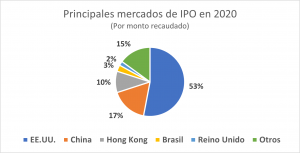2020 was a very active year for initial public offerings (IPOs). There were 1,415 registered worldwide, 36% more than in 2019, and activity is expected to be intense in 2021. What is an IPO? It is the procedure by which an unlisted company makes an offering of shares, new or existing, on the public capital market. To do so, the company must meet the requirements of the stock exchange where it will make the offering and register the shares, as well as those of the regulatory authorities of the market where the offering will take place.
According to the Corporate Finance Institute, an IPO in the U.S. involves five stages:
-
- Selection of the investment bank that will advise the company in the process and will provide the underwriting services.
- Due diligence and regulatory registration, a stage in which the advisory bank will determine the characteristics of the underwriting-the process by which an investment bank (the underwriter) acts as an intermediary between the issuing company and the investing public to help the issuing company sell its initial offering of shares-and the preparation and registration of the required documentation, including the offering prospectus and information for the regulatory authority.
- Pricing: Once the IPO is approved by the regulator and the date is set, the amount and price at which the shares will be offered is established.
- Stabilization period, in which the underwriter will disseminate analysts' recommendations and perform post-IPO stabilization tasks, intervening in the market to correct imbalances or distortions. This can only be done for a short period of time.
- Transition to the competitive market, a period during which the underwriter cannot provide information on its estimates of earnings and valuation of the company issuing the shares. company issuing the shares. In the U.S. this period is 25 days.
Through an IPO, a company can raise capital from the public by offering shares in the primary market. It is also a mechanism through which the company's founders and its shareholders can exit from ownership of the company, or reduce their stake in it, realizing the proceeds of their private investment.


